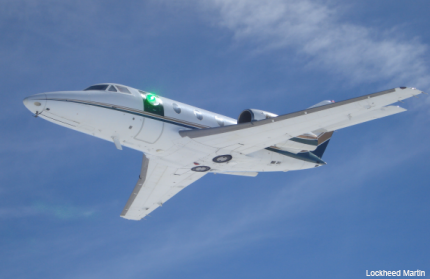Lockheed turret can give jets a 360-degree laser weapon
The prototype, developed for DARPA and AFRL, neutralizes of effect of turbulence that would limit lasers to firing only straight ahead.

A green, low-power laser beam passes through the ABC turret on a research aircraft.
Defense contractor Lockheed Martin says it has solved one of the key problems facing the military’s plans for high-powered airborne laser weapons, by counteracting the atmospheric turbulence that prevents a laser from having the ability to fire in all directions.
The Aero-adaptive Aero-optic Beam Control (ABC) turret, developed for the Defense Advanced Research Projects Agency and the Air Force Research Laboratory, is the first to demonstrate a full 360-degree range on an aircraft traveling near the speed of sound, Lockheed announced. Using a business jet as a test bed, the company said it has demonstrated the prototype turret’s capability in nearly 60 flight tests last year and this year.
In typical circumstances, turbulence would prevent an aircraft traveling near the speed of sound from firing anywhere but right in front of it. ABC minimizes the turbulence’s impact by using the latest aerodynamic and flow-control technology, enabling the laser to fire in any direction, Lockheed said.
“This advanced turret design will enable tactical aircraft to have the same laser weapon system advantages as ground vehicles and ships,” Doug Graham, vice president of missile systems and advanced programs for Lockheed Martin Space Systems’ Strategic and Missile Defense Systems, said in a statement.
The military has been working to develop laser weapons for variety of platforms, both on land and at sea. DARPA and AFRL, meanwhile, have been aiming to get lasers aboard fighters and other aircraft.
The High-Energy Liquid Laser Area Defense System, or HELLADS program, which is jointly funded by DARPA and AFRL, earlier this year moved from the laboratory to active field tests. HELLADS aims to develop a laser capable of 150-kilowatt bursts while being small and light enough to fit inside an aircraft.
For now, those field tests, at White Sands Missile Range, N.M., are ground-based, after which DARPA and AFRL plan to make the system available to the military services for further work. Having the 360-degree ABC turret could open a new range of possibilities.




